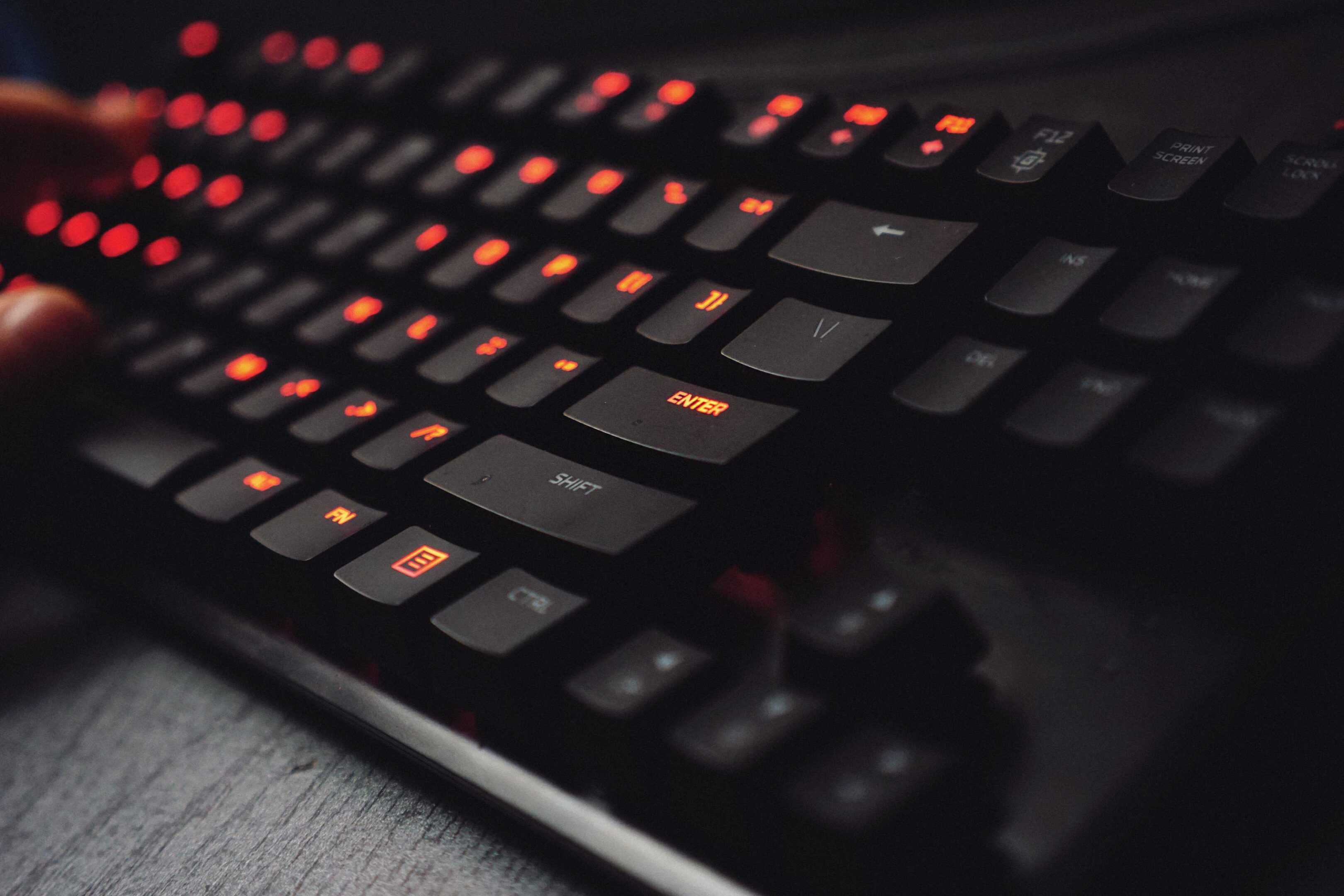Mechanical keyboards are recognized for their tactile feel and satisfying clicks, but they can also be quite noisy. If you prefer a quieter typing experience, there are several switch options and techniques you can use to create a more peaceful workspace. The best switch for you will depend on your individual preferences. Consider the type of typing experience you desire: do you prefer a smooth or tactile feel? How quiet do you need your keyboard to be? It’s a good idea to test out different switches to find the one you like best.
Mechanical Keyboard Switches for Quiet Typing
Mechanical keyboards are popular. People like them because they give good feedback and are very durable. But they can be noisy. This can be a problem if you share a workspace or want to use your keyboard for streaming. If you want a quieter typing experience, you need to choose your switches carefully.
Switch Types
Mechanical keyboard switches come in three main types: linear, tactile, and clicky.
- Linear switches have a smooth keystroke with no tactile bump or click. These are often quieter than tactile or clicky switches.
- Tactile switches have a bump when you press them. This helps you know when the keystroke is activated. They are often quieter than clicky switches but not as quiet as linear switches.
- Clicky switches are like tactile switches, but they also make a clicking sound. These are the loudest type of switch.
Quiet Switch Options
Here are some quiet mechanical keyboard switch options:
| Switch | Type | Sound Level | Feel |
|---|---|---|---|
| Cherry MX Red Silent | Linear | Very Quiet | Smooth |
| Cherry MX Black Silent | Linear | Very Quiet | Heavy |
| Gateron Silent Red | Linear | Very Quiet | Smooth, light |
| Kailh BOX Silent Brown | Tactile | Quiet | Tactile bump |
| ZealPC Zilents V2 | Linear | Very Quiet | Smooth, customizable |
These switches use dampeners or other methods to reduce the sound of the keystroke. This makes them a good choice for people who want a quiet typing experience.
Other Factors to Consider
- Keycaps: Thick PBT keycaps can help to reduce noise.
- Case: Some keyboard cases are designed to absorb sound.
- Typing Style: How hard you type can affect the noise level.
Membrane Keyboards: A Quieter Alternative
If you need a very quiet keyboard, you might consider a membrane keyboard. Membrane keyboards don’t use mechanical switches. They use a rubber dome to register keystrokes. This makes them much quieter than even the quietest mechanical keyboard. However, membrane keyboards don’t have the same feel or durability as mechanical keyboards.
Hush-Hush Keys: The Silent Side of Mechanical Keyboards
Top Contenders for Silent Typing
For those who value peace and quiet, several mechanical switch options stand out:
- Cherry MX Silent Red: These linear switches feature a dampening mechanism to reduce noise. They offer a smooth, consistent keystroke without the typical “click” sound.
- Gateron Silent Brown: Tactile switches with a subtle bump upon actuation. Their built-in dampeners make them quieter than standard brown switches while retaining the tactile feel.
- ZealPC Silent Zealios: Known for their smooth, consistent feel and reduced noise. They’re a premium option for those seeking the best typing experience.
- Kailh BOX Silent Pink: These linear switches boast a unique BOX design that contributes to their quiet operation and durability.
- NovelKeys Creams: Linear switches with a slightly heavier actuation force. Their smooth travel and minimal noise make them popular among quiet typists.

Switch Lubing for Silence
Applying lubricant to your switches can further reduce noise and improve their overall feel. This involves disassembling your keyboard and applying a small amount of lubricant to each switch. It’s a more involved process but can significantly enhance your typing experience.
Silent Alternatives to Mechanical
If you need an even quieter option, consider membrane or scissor-switch keyboards. While they lack the tactile feedback and longevity of mechanical switches, they are generally much quieter.
Silent Switch Comparison Table
| Switch | Type | Actuation Force (g) | Sound Level | Notes |
|---|---|---|---|---|
| Cherry MX Silent Red | Linear | 45 | Very Quiet | Popular for gaming and typing |
| Gateron Silent Brown | Tactile | 55 | Quiet | Offers tactile feedback |
| ZealPC Silent Zealios | Linear | 65-67 | Very Quiet | Premium option, smooth feel |
| Kailh BOX Silent Pink | Linear | 50 | Quiet | Unique BOX design, durable |
| NovelKeys Creams | Linear | 65 | Quiet | Heavier actuation, smooth travel |

Understanding Mechanical Keyboard Switch Types
Mechanical keyboards are famous for their distinct types of key switches that can change the typing experience. They vary based on sound, feel, and the force needed to press the keys.
Anatomy of Mechanical Switches
Mechanical switches sit right beneath the keycaps. Each switch consists of several components that determine how it performs when pressed. The most important parts include the stem that moves down when a key is pressed, the spring that provides the resistance and resets the key to its original position, and the housing that holds all the parts together. The actuation point is the specific distance at which a keypress is recognized, while the total travel distance is how far the stem can move down.
Linear Versus Tactile Versus Clicky
Linear switches feature a smooth keystroke without any tactile feedback or clicking noise. They’re preferred for their consistent and quiet press, which usually requires less force, measured in grams. Linear switches are often favored for gaming due to their straightforward motion.
Tactile switches, on the other hand, provide tactile feedback. You’ll feel a slight bump at the actuation point, helping to confirm the key press without needing to press the key all the way down. This feedback is useful for typing, as it can prevent errors and reduce fatigue.
Clicky switches are known for their distinctive click sound at the actuation point. They provide both tactile feedback and an audible click to confirm the keypress. These switches often require a bit more force and have a higher total travel distance, making them less quiet than linear or tactile switches.
Quietest Mechanical Keyboard Switches
When building or buying a mechanical keyboard, those who favor a quieter typing experience often seek out the quietest switches. These typically have built-in dampeners that soften the sound of each keypress.
Cherry MX Silent Series
Among the esteemed choices, Cherry MX Silent switches stand out for their sound dampening technology. The Cherry MX Silent Red is especially sought after for its quiet and smooth actuation, providing a virtually noiseless typing experience without the audible click. Equipped with integrated rubber o-rings, these switches reduce the noise typically associated with key bottoming out and rebounding.
Gateron Silent Models
Gateron Silent switches offer an alternative with their own range of silent models. These switches use soft materials within the switch to achieve a quieter sound profile, allowing for a discrete typing experience. They are especially appreciated by users who work in shared spaces or enjoy gaming late at night without disturbing others.
Other Silent Mechanical Switches
Besides Cherry and Gateron, numerous manufacturers have developed their own silent switches. The ZealPC Healios are premium quiet linear switches noted for their minimal sound output but at a higher price point. The Gazzew Boba U4 is another switch that’s often recommended for its tactility and quietness. Durock Silent Linears are noteworthy for their super smooth and quiet operation, available in different weights to match user preference. Lastly, Kailh BOX Silent Pink switches make their mark by offering a dampened typing experience to those who want a quieter keyboard without losing the mechanical feel.
Top Quiet Mechanical Keyboards and Modifications
When it comes to creating a silent typing experience, selecting the right quiet mechanical keyboards and applying effective modifications are essential.
Recommended Quiet Mechanical Keyboards
Several mechanical keyboards stand out for their quiet operation, much appreciated by gamers and professionals alike:
- Logitech G915 TKL: This wireless keyboard is known for its sleek design, RGB lighting, and quiet, low-profile mechanical switches. It’s a favorite among those who prefer a clean desk setup without sacrificing the tactile feedback of mechanical switches.
- Keychron K6: A versatile option that offers both wired and wireless functionality, the Keychron K6 works with PBT keycaps and can be customized to improve its already excellent noise performance.
- Ducky One 2 Mini: Despite its smaller size, it provides exceptional build quality and a solid typing experience with minimal noise—great for gamers and typists.
- Corsair Strafe RGB MK.2: Recognized for its durable build and silent switches, this full-sized keyboard also boasts programmable macros and multimedia controls.
- Type-S Topre: Offering a unique switch type that combines mechanical and rubber dome technologies, the Type-S Topre is known for its quiet keypresses and typing comfort.
These keyboards not only excel in providing a quieter typing experience but also offer features like customizable RGB lighting and programmable macros to enhance usability and aesthetics.
Keyboard Modification for Noise Reduction
To further reduce noise, one can implement several modifications:
- Switch Lubing: Applying lubricant to the switches can significantly reduce friction during keystrokes, leading to a quieter keyboard.
- Dampeners: Adding O-rings or foam pads under the keycaps can dampen the sound of the switch being pressed and released.
- Keycap Material: Switching to PBT keycaps can change the acoustics of the keyboard, often resulting in a less “pingy” noise when compared to ABS keycaps.
- Modding Stabilizers: Upgrading or lubing the stabilizers, which are used on larger keys, can reduce rattling sounds for a more consistent and quiet typing experience.
By combining a quiet mechanical keyboard with these sound-dampening modifications, users can achieve a near-silent typing experience while still enjoying the benefits of mechanical keys.
Frequently Asked Questions
This section covers common queries about the quietest switches for mechanical keyboards, along with precise comparisons and suggestions tailored to different needs.
What are the best silent linear switches for a mechanical keyboard?
Gateron Silent Reds are often suggested for their smooth keystroke and affordability. They are a top choice for users looking for minimal sound without breaking the bank.
Can you recommend quiet clicky switches for typing?
Although ‘clicky’ switches are generally louder, options like the Cherry MX Silent switches provide a quieter typing experience with the tactile feedback that many people enjoy.
Which switches would be ideal for a silent gaming mechanical keyboard?
Cherry MX Red or Silent Red switches are typically recommended for gaming. They offer a good balance of responsiveness and low noise level, which is perfect for gamers needing to play without excess sound.
What are the characteristics of Cherry MX Silent Red switches versus other silent options?
Cherry MX Silent Reds are known for their smooth linear motion and minimal noise. They are durable and offer a slightly softer landing during actuation compared to other silent linear switches.
How do Kailh Prestige Silent switches compare to other brands for noise reduction?
Kailh Prestige Silent switches are claimed to be competitively quiet and are praised for their sound dampening characteristics. They’re another solid choice for those prioritizing a noiseless environment.
Are there silent tactile switches that offer a quiet typing experience without sacrificing feedback?
Yes, there are silent tactile switches like Zilent V2 switches by Zeal PC that provide tactile feedback with reduced sound. They’re engineered for silence but maintain a discernable bump to satisfy tactile preference.





